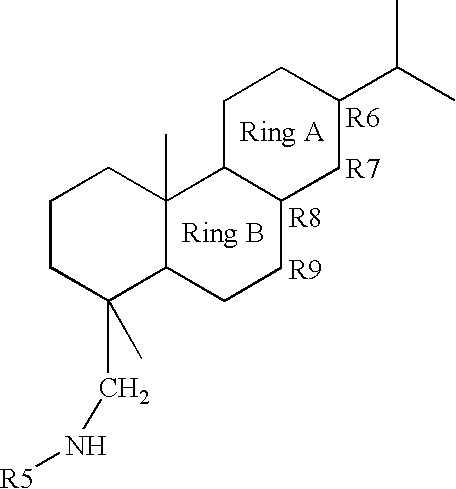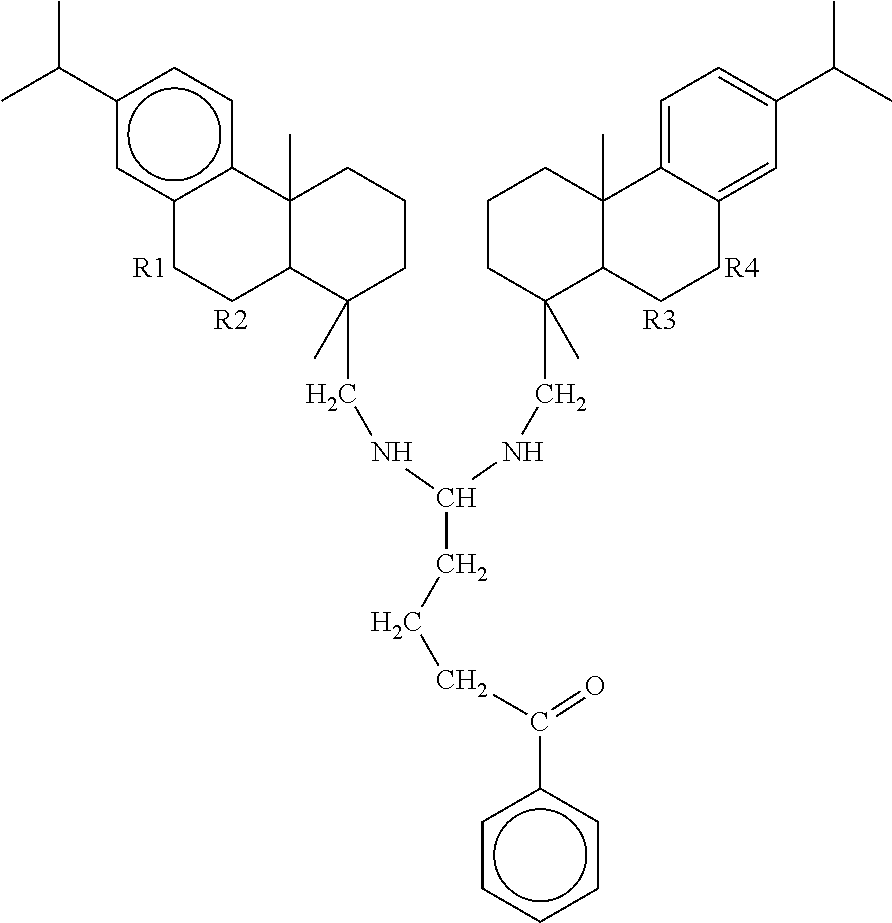Corrosion inhibitor formulations with improved performance, lower toxicity and reduced manufacturing hazards
a technology of corrosion inhibitors and formulations, which is applied in the direction of detergent compositions, detergent compounding agents, other chemical processes, etc., can solve the problems of affecting the functioning of the aforementioned units, affecting the safety of workers,
- Summary
- Abstract
- Description
- Claims
- Application Information
AI Technical Summary
Benefits of technology
Problems solved by technology
Method used
Image
Examples
example 1
[0080]To a 1 liter 3 neck round bottom flask equipped with a water-cooled condenser, overhead mixer, thermocouple / heating mantle, sealed and under slight nitrogen pressure (via bubbler), added (with continued mixing throughout):[0081]450 g Corsamine DHA[0082]130.14 g acetophenone[0083]154.8 g glycolic acid (70%) added all at once without fuming.
[0084]After acid addition, temperature increased from 23 to 59 deg. C., a 36 deg. C. exotherm. With temperature at 60 deg. C., 70.86 g 92% paraformaldehyde was added (×2 equivalents versus acetophenone) and then 105.33 g deionized water.
[0085]The mixture was warmed to 80 deg. C. The solution became milky as the paraformaldehyde decomposed. The mixture was allowed to cool to 75 deg. C. and held for 30 minutes during which time the solution became clear. The mixture was warmed to 90 deg. C. and held 12 hours (remained clear). The resulting substance was then cooled to room temperature and the solution was a clear / amber moderately viscous soluti...
example 2 (
Comparative: HCl was Used in Place of Glycolic Acid)
[0087]To a 100 ml 3 neck round bottom flask equipped with a water-cooled condenser, overhead mixer, thermocouple / heating mantle, sealed and under slight nitrogen pressure (via bubbler) added (with continued mixing throughout):[0088]25.0 g Corsamine DHA[0089]7.25 g acetophenone[0090]9.28 g 20′ baume hydrochloric acid (20′=˜32% wt / st HCl in H2O) added slowly (generated dense white fumes and solution became greenish in color.
[0091]After acid addition, the temperature increased from 23 to 50 deg. C., a 27 deg. C. exotherm.
[0092]The mixture was warmed to 60 deg. C. and 3.93 g 92% paraformaldehyde and 6.53 g deionized water added, and then the mixture was warmed to 70 deg. C., and held for 30 minutes. The mixture was then warmed to 90 deg. C. and held 12 hours. The resulting solution was cooled to a highly viscous, amber / brown / opaque material. Residual formaldehyde was 276 ppm.
example 3 (
Like Example 1 but 1 / 10 the Size and 10% Less Acetophenone)
[0093]To a 100 ml 3 neck round bottom flask equipped with a water-cooled condenser, overhead mixer, thermocouple / heating mantle, sealed and under slight nitrogen pressure (via bubbler) added (with continued mixing throughout):[0094]45.0 g Corsamine DHA[0095]11.74 g acetophenone[0096]15.48 g glycolic acid (70%) added all at once without fuming.
[0097]After acid addition, temperature increased from 23 to 59 deg. C., a 36 deg. C. exotherm. With temperature at 60 deg. C. 7.09 g 92% paraformaldehyde was added and then 10.53 g deionized water. The mixture was warmed to 70 deg. C. and held for 30 minutes.
[0098]The mixture was then warmed to 90 deg. C. and held 12 hours (remained clear). Residual formaldehyde was 130 ppm.
PUM
| Property | Measurement | Unit |
|---|---|---|
| Temperatures | aaaaa | aaaaa |
| molar ratio | aaaaa | aaaaa |
| vapor pressure | aaaaa | aaaaa |
Abstract
Description
Claims
Application Information
 Login to View More
Login to View More - R&D
- Intellectual Property
- Life Sciences
- Materials
- Tech Scout
- Unparalleled Data Quality
- Higher Quality Content
- 60% Fewer Hallucinations
Browse by: Latest US Patents, China's latest patents, Technical Efficacy Thesaurus, Application Domain, Technology Topic, Popular Technical Reports.
© 2025 PatSnap. All rights reserved.Legal|Privacy policy|Modern Slavery Act Transparency Statement|Sitemap|About US| Contact US: help@patsnap.com


